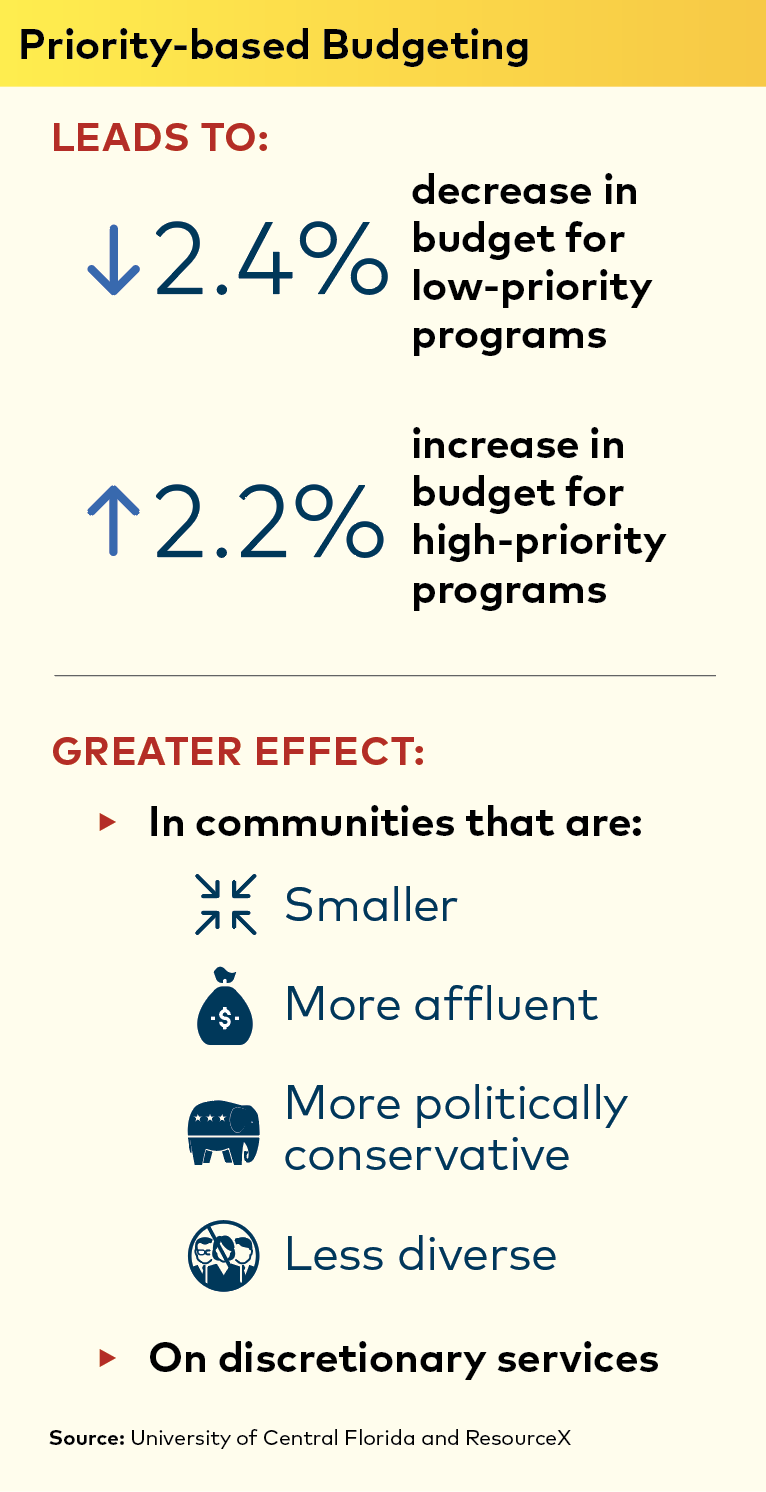Priority-based budgeting (PBB) marks the latest attempt to revamp how local governments allocate their dollars among their departments. Implemented in over 300 municipalities across North America, PBB is designed to identify an organization’s service-delivery programs and their associated costs, determine organizational priorities, rate the programs according to their alignment with said priorities and then reallocate budgetary resources from lower-priority programs to the higher priority ones.
PBB has been advertised as a budget reduction tool and a strategic alternative to align resources with organizational goals. PBB has been recognized by the International City/County Management Association (ICCMA) as a leading practice and as a best practice by the Government Finance Officers Association (GFOA) and the National League of Cities (NLC).
A team of University of Central Florida (UCF) public budgeting scholars has partnered with ResourceX, the leading PBB consulting firm, to examine the departmental budgetary trends within 32 U.S. local governments that were among the earliest PBB adopters. The study determined that PBB led to a 2.4% reduction in funding for programs in the lowest quartile of priority, while all others received a 2.2% budgetary increase. For the average local government in the study, this difference translated to a $900,000 transfer of funds within a $73 million budget. While this level is significant, it must be considered against the substantial upfront organizational burden to identify program costs and organizational priorities, which leaves some to question whether this level of reallocation is worth all the work.

However, further research indicated that PBB might work in some communities better than others. The more politically conservative communities in the study witnessed a 10.2% reduction in funding for their lowest-priority programs, almost 8% more than average. Those local governments that received the most federal and state assistance saw an 8% reduction for lower-priority programs. Communities with a smaller population, more affluence or less racial diversity each produced approximately 5% reductions. Interestingly, in all of these cases, there was not a fully corresponding increase for higher-priority programs, meaning the reallocated funds were put toward capital projects, put toward organizational reserves or used to address budgetary deficits. Additional research is necessary to understand this dynamic better.
The research indicates that PBB disproportionately impacts some municipal functions while others are largely exempt. Core functions such as public safety and public works did not see significant budgetary reductions in their lower-priority programs, but the budget for higher-priority programs in these departments largely remained static as well. For these functions, broader factors such as shifts in community population, politics, income and age tended to drive budgetary changes. However, the more discretionary functions such as planning and development, quality of life and general administration encountered relatively deep cuts to their lower-priority programs, ranging from 4-6%. Higher-priority programs in these departments received 1-4% budgetary increases, indicating that the logic behind PBB rings truer for discretionary functions.
These findings indicate that PBB is not a “silver bullet” to slash budgets, align dollars with goals or achieve strategic objectives. However, it has proven to be a useful budgetary tool, especially in particular contexts. PBB appears to be most effective in more homogenous, resource-rich environments where budgetary conflict is less prevalent. PBB looks to be more impactful for marginal, discretionary functions, working at the edges of government without threatening core services. Thus, while implementing PBB may not single-handedly eliminate a substantial structural budget deficit or overcome diverse and deep community divisions, the system can streamline municipal functions and free up significant funds to be reoriented toward organizational priorities. Local governments should weigh these benefits against the often substantial organizational burden of implementing PBB.
More and more local governments implement PBB each year and generate impressive success stories that indicate a staying power for the budgetary approach beyond the typical “management fad.” However, a savvy municipal leader recognizes that even the most effective tools work best only in certain contexts. Do you wish to overcome a fractious and divisive budgetary fight, dramatically revamp the organizational budget or implement PBB without sufficient fiscal and administrative capacity? PBB may not be for you. Do you wish to engage the community collaboratively to streamline government, make measured investment toward community goals and have sufficient capacity to implement? In this case, research has demonstrated that priority-based budgeting can make the difference.
David Mitchell is an Assistant Professor at the University of Central Florida (UCF) School of Public Administration. Mitchell led the research team behind this study and specializes in public budgeting and strategic management within local governments.

